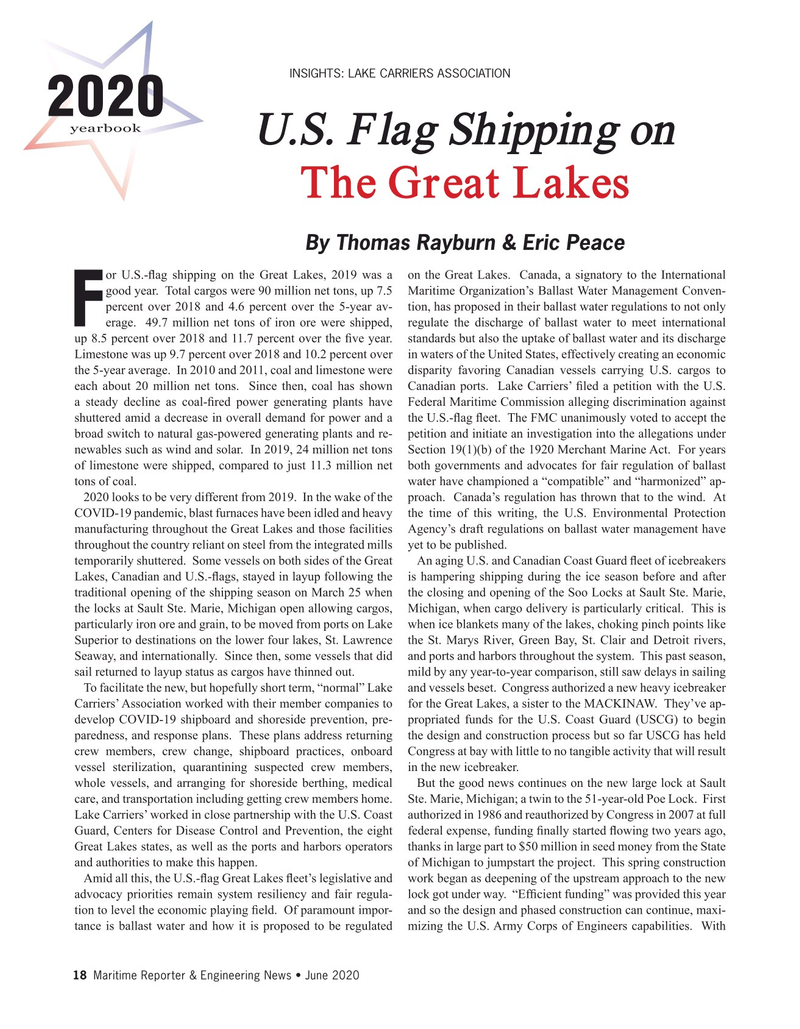
Page 18: of Maritime Reporter Magazine (June 2020)
2020 Yearbook
Read this page in Pdf, Flash or Html5 edition of June 2020 Maritime Reporter Magazine
INSIghtS: Lake CarrIerS aSSoCIatIoN 2020 yearbook
U.S. Flag Shipping on
The Great Lakes
By Thomas Rayburn & Eric Peace or U.S.-fag shipping on the Great Lakes, 2019 was a on the Great Lakes. Canada, a signatory to the International good year. Total cargos were 90 million net tons, up 7.5 Maritime Organization’s Ballast Water Management Conven- percent over 2018 and 4.6 percent over the 5-year av- tion, has proposed in their ballast water regulations to not only
Ferage. 49.7 million net tons of iron ore were shipped, regulate the discharge of ballast water to meet international up 8.5 percent over 2018 and 11.7 percent over the fve year. standards but also the uptake of ballast water and its discharge
Limestone was up 9.7 percent over 2018 and 10.2 percent over in waters of the United States, effectively creating an economic the 5-year average. In 2010 and 2011, coal and limestone were disparity favoring Canadian vessels carrying U.S. cargos to each about 20 million net tons. Since then, coal has shown Canadian ports. Lake Carriers’ fled a petition with the U.S. a steady decline as coal-fred power generating plants have Federal Maritime Commission alleging discrimination against shuttered amid a decrease in overall demand for power and a the U.S.-fag feet. The FMC unanimously voted to accept the broad switch to natural gas-powered generating plants and re- petition and initiate an investigation into the allegations under newables such as wind and solar. In 2019, 24 million net tons Section 19(1)(b) of the 1920 Merchant Marine Act. For years of limestone were shipped, compared to just 11.3 million net both governments and advocates for fair regulation of ballast tons of coal. water have championed a “compatible” and “harmonized” ap- 2020 looks to be very different from 2019. In the wake of the proach. Canada’s regulation has thrown that to the wind. At
COVID-19 pandemic, blast furnaces have been idled and heavy the time of this writing, the U.S. Environmental Protection manufacturing throughout the Great Lakes and those facilities Agency’s draft regulations on ballast water management have throughout the country reliant on steel from the integrated mills yet to be published.
temporarily shuttered. Some vessels on both sides of the Great An aging U.S. and Canadian Coast Guard feet of icebreakers
Lakes, Canadian and U.S.-fags, stayed in layup following the is hampering shipping during the ice season before and after traditional opening of the shipping season on March 25 when the closing and opening of the Soo Locks at Sault Ste. Marie, the locks at Sault Ste. Marie, Michigan open allowing cargos, Michigan, when cargo delivery is particularly critical. This is particularly iron ore and grain, to be moved from ports on Lake when ice blankets many of the lakes, choking pinch points like
Superior to destinations on the lower four lakes, St. Lawrence the St. Marys River, Green Bay, St. Clair and Detroit rivers,
Seaway, and internationally. Since then, some vessels that did and ports and harbors throughout the system. This past season, sail returned to layup status as cargos have thinned out. mild by any year-to-year comparison, still saw delays in sailing
To facilitate the new, but hopefully short term, “normal” Lake and vessels beset. Congress authorized a new heavy icebreaker
Carriers’ Association worked with their member companies to for the Great Lakes, a sister to the MACKINAW. They’ve ap- develop COVID-19 shipboard and shoreside prevention, pre- propriated funds for the U.S. Coast Guard (USCG) to begin paredness, and response plans. These plans address returning the design and construction process but so far USCG has held crew members, crew change, shipboard practices, onboard Congress at bay with little to no tangible activity that will result vessel sterilization, quarantining suspected crew members, in the new icebreaker.
whole vessels, and arranging for shoreside berthing, medical But the good news continues on the new large lock at Sault care, and transportation including getting crew members home. Ste. Marie, Michigan; a twin to the 51-year-old Poe Lock. First
Lake Carriers’ worked in close partnership with the U.S. Coast authorized in 1986 and reauthorized by Congress in 2007 at full
Guard, Centers for Disease Control and Prevention, the eight federal expense, funding fnally started fowing two years ago,
Great Lakes states, as well as the ports and harbors operators thanks in large part to $50 million in seed money from the State and authorities to make this happen. of Michigan to jumpstart the project. This spring construction
Amid all this, the U.S.-fag Great Lakes feet’s legislative and work began as deepening of the upstream approach to the new advocacy priorities remain system resiliency and fair regula- lock got under way. “Effcient funding” was provided this year tion to level the economic playing feld. Of paramount impor- and so the design and phased construction can continue, maxi- tance is ballast water and how it is proposed to be regulated mizing the U.S. Army Corps of Engineers capabilities. With 18 Maritime Reporter & Engineering News • June 2020

 17
17

 19
19
